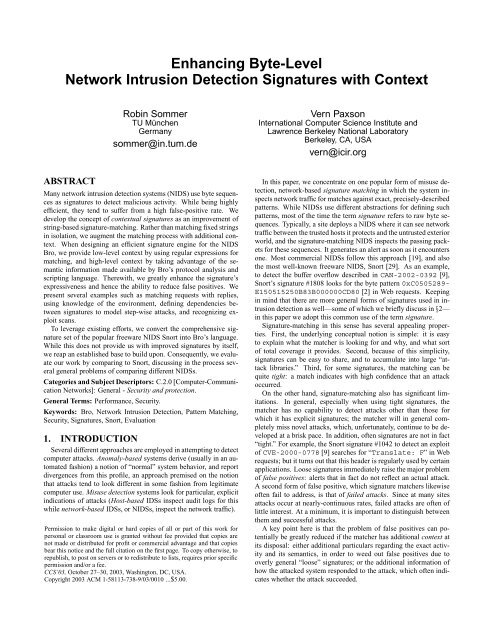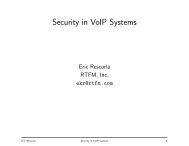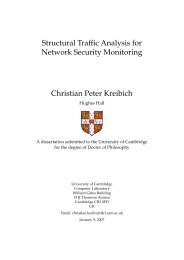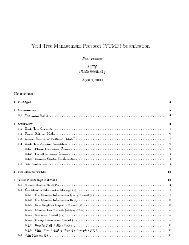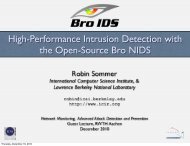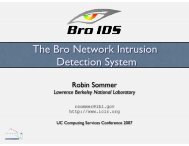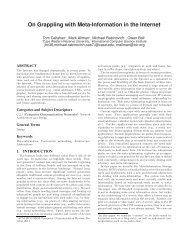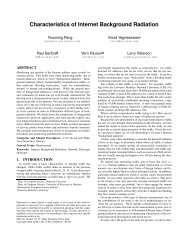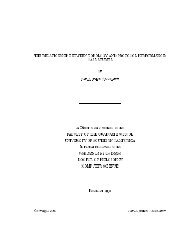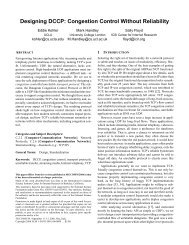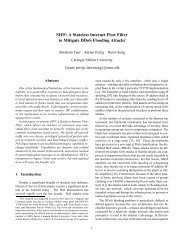Enhancing Byte-Level Network Intrusion Detection Signatures with ...
Enhancing Byte-Level Network Intrusion Detection Signatures with ...
Enhancing Byte-Level Network Intrusion Detection Signatures with ...
Create successful ePaper yourself
Turn your PDF publications into a flip-book with our unique Google optimized e-Paper software.
<strong>Enhancing</strong> <strong>Byte</strong>-<strong>Level</strong><br />
<strong>Network</strong> <strong>Intrusion</strong> <strong>Detection</strong> <strong>Signatures</strong> <strong>with</strong> Context<br />
ABSTRACT<br />
Robin Sommer<br />
TU München<br />
Germany<br />
sommer@in.tum.de<br />
Many network intrusion detection systems (NIDS) use byte sequences<br />
as signatures to detect malicious activity. While being highly<br />
efficient, they tend to suffer from a high false-positive rate. We<br />
develop the concept of contextual signatures as an improvement of<br />
string-based signature-matching. Rather than matching fixed strings<br />
in isolation, we augment the matching process <strong>with</strong> additional context.<br />
When designing an efficient signature engine for the NIDS<br />
Bro, we provide low-level context by using regular expressions for<br />
matching, and high-level context by taking advantage of the semantic<br />
information made available by Bro’s protocol analysis and<br />
scripting language. There<strong>with</strong>, we greatly enhance the signature’s<br />
expressiveness and hence the ability to reduce false positives. We<br />
present several examples such as matching requests <strong>with</strong> replies,<br />
using knowledge of the environment, defining dependencies between<br />
signatures to model step-wise attacks, and recognizing exploit<br />
scans.<br />
To leverage existing efforts, we convert the comprehensive signature<br />
set of the popular freeware NIDS Snort into Bro’s language.<br />
While this does not provide us <strong>with</strong> improved signatures by itself,<br />
we reap an established base to build upon. Consequently, we evaluate<br />
our work by comparing to Snort, discussing in the process several<br />
general problems of comparing different NIDSs.<br />
Categories and Subject Descriptors: C.2.0 [Computer-Communication<br />
<strong>Network</strong>s]: General - Security and protection.<br />
General Terms: Performance, Security.<br />
Keywords: Bro, <strong>Network</strong> <strong>Intrusion</strong> <strong>Detection</strong>, Pattern Matching,<br />
Security, <strong>Signatures</strong>, Snort, Evaluation<br />
1. INTRODUCTION<br />
Several different approaches are employed in attempting to detect<br />
computer attacks. Anomaly-based systems derive (usually in an automated<br />
fashion) a notion of “normal” system behavior, and report<br />
divergences from this profile, an approach premised on the notion<br />
that attacks tend to look different in some fashion from legitimate<br />
computer use. Misuse detection systems look for particular, explicit<br />
indications of attacks (Host-based IDSs inspect audit logs for this<br />
while network-based IDSs, or NIDSs, inspect the network traffic).<br />
Permission to make digital or hard copies of all or part of this work for<br />
personal or classroom use is granted <strong>with</strong>out fee provided that copies are<br />
not made or distributed for profit or commercial advantage and that copies<br />
bear this notice and the full citation on the first page. To copy otherwise, to<br />
republish, to post on servers or to redistribute to lists, requires prior specific<br />
permission and/or a fee.<br />
CCS’03, October 27–30, 2003, Washington, DC, USA.<br />
Copyright 2003 ACM 1-58113-738-9/03/0010 ...$5.00.<br />
Vern Paxson<br />
International Computer Science Institute and<br />
Lawrence Berkeley National Laboratory<br />
Berkeley, CA, USA<br />
vern@icir.org<br />
In this paper, we concentrate on one popular form of misuse detection,<br />
network-based signature matching in which the system inspects<br />
network traffic for matches against exact, precisely-described<br />
patterns. While NIDSs use different abstractions for defining such<br />
patterns, most of the time the term signature refers to raw byte sequences.<br />
Typically, a site deploys a NIDS where it can see network<br />
traffic between the trusted hosts it protects and the untrusted exterior<br />
world, and the signature-matching NIDS inspects the passing packets<br />
for these sequences. It generates an alert as soon as it encounters<br />
one. Most commercial NIDSs follow this approach [19], and also<br />
the most well-known freeware NIDS, Snort [29]. As an example,<br />
to detect the buffer overflow described in CAN-2002-0392 [9],<br />
Snort’s signature #1808 looks for the byte pattern 0xC0505289-<br />
E150515250B83B000000CD80 [2] in Web requests. Keeping<br />
in mind that there are more general forms of signatures used in intrusion<br />
detection as well—some of which we briefly discuss in §2—<br />
in this paper we adopt this common use of the term signature.<br />
Signature-matching in this sense has several appealing properties.<br />
First, the underlying conceptual notion is simple: it is easy<br />
to explain what the matcher is looking for and why, and what sort<br />
of total coverage it provides. Second, because of this simplicity,<br />
signatures can be easy to share, and to accumulate into large “attack<br />
libraries.” Third, for some signatures, the matching can be<br />
quite tight: a match indicates <strong>with</strong> high confidence that an attack<br />
occurred.<br />
On the other hand, signature-matching also has significant limitations.<br />
In general, especially when using tight signatures, the<br />
matcher has no capability to detect attacks other than those for<br />
which it has explicit signatures; the matcher will in general completely<br />
miss novel attacks, which, unfortunately, continue to be developed<br />
at a brisk pace. In addition, often signatures are not in fact<br />
“tight.” For example, the Snort signature #1042 to detect an exploit<br />
of CVE-2000-0778 [9] searches for “Translate: F” in Web<br />
requests; but it turns out that this header is regularly used by certain<br />
applications. Loose signatures immediately raise the major problem<br />
of false positives: alerts that in fact do not reflect an actual attack.<br />
A second form of false positive, which signature matchers likewise<br />
often fail to address, is that of failed attacks. Since at many sites<br />
attacks occur at nearly-continuous rates, failed attacks are often of<br />
little interest. At a minimum, it is important to distinguish between<br />
them and successful attacks.<br />
A key point here is that the problem of false positives can potentially<br />
be greatly reduced if the matcher has additional context at<br />
its disposal: either additional particulars regarding the exact activity<br />
and its semantics, in order to weed out false positives due to<br />
overly general “loose” signatures; or the additional information of<br />
how the attacked system responded to the attack, which often indicates<br />
whether the attack succeeded.
In this paper, we develop the concept of contextual signatures,<br />
in which the traditional form of string-based signature matching is<br />
augmented by incorporating additional context on different levels<br />
when evaluating the signatures. First of all, we design and implement<br />
an efficient pattern matcher similar in spirit to traditional signature<br />
engines used in other NIDS. But already on this low-level<br />
we enable the use of additional context by (i) providing full regular<br />
expressions instead of fixed strings, and (ii) giving the signature<br />
engine a notion of full connection state, which allows it to correlate<br />
multiple interdependent matches in both directions of a user<br />
session. Then, if the signature engine reports the match of a signature,<br />
we use this event as the start of a decision process, instead<br />
of an alert by itself as is done by most signature-matching NIDSs.<br />
Again, we use additional context to judge whether something alertworthy<br />
has indeed occurred. This time the context is located on a<br />
higher-level, containing our knowledge about the network that we<br />
have either explicitly defined or already learned during operation.<br />
In §3.5, we will show several examples to demonstrate how the<br />
concept of contextual signatures can help to eliminate most of the<br />
limitations of traditional signatures discussed above. We will see<br />
that regular expressions, interdependent signatures, and knowledge<br />
about the particular environment have significant potential to reduce<br />
the false positive rate and to identify failed attack attempts. For<br />
example, we can consider the server’s response to an attack and<br />
the set of software it is actually running—its vulnerability profile—<br />
to decide whether an attack has succeeded. In addition, treating<br />
signature matches as events rather than alerts enables us to analyze<br />
them on a meta-level as well, which we demonstrate by identifying<br />
exploit scans (scanning multiple hosts for a known vulnerability).<br />
Instrumenting signatures to consider additional context has to be<br />
performed manually. For each signature, we need to determine what<br />
context might actually help to increase its performance. While this<br />
is tedious for large sets of already-existing signatures, it is not an<br />
extra problem when developing new ones, as such signatures have<br />
to be similarly adjusted to the specifics of particular attacks anyway.<br />
Contextual signatures serve as a building block for increasing the<br />
expressivess of signatures; not as a stand-alone solution.<br />
We implemented the concept of contextual signatures in the<br />
framework already provided by the freeware NIDS Bro [25]. In<br />
contrast to most NIDSs, Bro is fundamentally neither an anomalybased<br />
system nor a signature-based system. It is instead partitioned<br />
into a protocol analysis component and a policy script component.<br />
The former feeds the latter via generating a stream of events that<br />
reflect different types of activity detected by the protocol analysis;<br />
consequently, the analyzer is also referred to as the event engine.<br />
For example, when the analyzer sees the establishment of<br />
a TCP connection, it generates a connection established<br />
event; when it sees an HTTP request it generates http request<br />
and for the corresponding reply http reply; and when the event<br />
engine’s heuristics determine that a user has successfully authenticated<br />
during a Telnet or Rlogin session, it generates login success<br />
(likewise, each failed attempt results in a login failure<br />
event).<br />
Bro’s event engine is policy-neutral: it does not consider any<br />
particular events as reflecting trouble. It simply makes the events<br />
available to the policy script interpreter. The interpreter then executes<br />
scripts written in Bro’s custom scripting language in order<br />
to define the response to the stream of events. Because the language<br />
includes rich data types, persistent state, and access to timers<br />
and external programs, the response can incorporate a great deal of<br />
context in addition to the event itself. The script’s reaction to a particular<br />
event can range from updating arbitrary state (for example,<br />
tracking types of activity by address or address pair, or grouping re-<br />
lated connections into higher-level “sessions”) to generating alerts<br />
(e.g., via syslog) or invoking programs for a reactive response.<br />
More generally, a Bro policy script can implement signature-style<br />
matching—for example, inspecting the URIs in Web requests, the<br />
MIME-encoded contents of email (which the event engine will first<br />
unpack), the user names and keystrokes in login sessions, or the<br />
filenames in FTP sessions—but at a higher semantic level than as<br />
just individual packets or generic TCP byte streams.<br />
Bro’s layered approach is very powerful as it allows a wide range<br />
of different applications. But it has a significant shortcoming:<br />
while, as discussed above, the policy script is capable of performing<br />
traditional signature-matching, doing so can be cumbersome for<br />
large sets of signatures, because each signature has to be coded as<br />
part of a script function. This is in contrast to the concise, low-level<br />
languages used by most traditional signature-based systems. In addition,<br />
if the signatures are matched sequentially, then the overhead<br />
of the matching can become prohibitive. Finally, a great deal of<br />
community effort is already expended on developing and disseminating<br />
packet-based and byte-stream-based signatures. For example,<br />
the 1.9.0 release of Snort comes <strong>with</strong> a library of 1,715 signatures<br />
[2]. It would be a major advantage if we could leverage these<br />
efforts by incorporating such libraries.<br />
Therefore, one motivation for this work is to combine Bro’s flexibility<br />
<strong>with</strong> the capabilities of other NIDSs by implementing a signature<br />
engine. But in contrast to traditional systems, which use their<br />
signature matcher more or less on its own, we tightly integrate it<br />
into Bro’s architecture in order to provide contextual signatures. As<br />
discussed above, there are two main levels on which we use additional<br />
context for signature matching. First, at a detailed level, we<br />
extend the expressiveness of signatures. Although byte-level pattern<br />
matching is a central part of NIDSs, most only allow signatures to<br />
be expressed in terms of fixed strings. Bro, on the other hand, already<br />
provides regular expressions for use in policy scripts, and we<br />
use them for signatures as well. The expressiveness of such patterns<br />
provides us <strong>with</strong> an immediate way to express syntactic context.<br />
For example, <strong>with</strong> regular expressions it is easy to express the notion<br />
“string XYZ but only if preceded at some point earlier by string<br />
ABC”. An important point to keep in mind regarding regular expression<br />
matching is that, once we have fully constructed the matcher,<br />
which is expressed as a Deterministic Finite Automaton (DFA), the<br />
matching can be done in O(n) time for n characters in the input,<br />
and also Ω(n) time. (That is, the matching always takes time linear<br />
in the size of the input, regardless of the specifics of the input.) The<br />
“parallel Boyer-Moore” approaches that have been explored in the<br />
literature for fast matching of multiple fixed strings for Snort [12, 8]<br />
have a wide range of running times—potentially sublinear in n, but<br />
also potentially superlinear in n. So, depending on the particulars<br />
of the strings we want to match and the input against which we do<br />
the matching, regular expressions might prove fundamentally more<br />
efficient, or might not; we need empirical evaluations to determine<br />
the relative performance in practice. In addition, the construction of<br />
a regular expression matcher requires time potentially exponential<br />
in the length of the expression, clearly prohibitive, a point to which<br />
we return in §3.1.<br />
Second, on a higher level, we use Bro’s rich contextual state to<br />
implement our improvements to plain matching described above.<br />
Making use of Bro’s architecture, our engine sends events to the<br />
policy layer. There, the policy script can use all of Bro’s already<br />
existing mechanisms to decide how to react. We show several such<br />
examples in §3.5.<br />
Due to Snort’s large user base, it enjoys a comprehensive and<br />
up-to-date set of signatures. Therefore, although for flexibility we<br />
have designed a custom signature language for Bro, we make use
of the Snort libraries via a conversion program. This program takes<br />
an unmodified Snort configuration and creates a corresponding Bro<br />
signature set. Of course, by just using the same signatures in Bro as<br />
in Snort, we are not able to improve the resulting alerts in terms of<br />
quality. But even if we do not accompany them <strong>with</strong> additional<br />
context, they immediately give us a baseline of already widelydeployed<br />
signatures. Consequently, Snort serves us as a reference.<br />
Throughout the paper we compare <strong>with</strong> Snort both in terms of quality<br />
and performance. But while doing so, we encountered several<br />
general problems for evaluating and comparing NIDSs. We believe<br />
these arise independently of our work <strong>with</strong> Bro and Snort, and<br />
therefore describe them in some detail. Keeping these limitations<br />
in mind, we then evaluate the performance of our signature engine<br />
and find that it performs well.<br />
§2 briefly summarizes related work. In §3 we present the main<br />
design ideas behind implementing contextual signatures: regular<br />
expressions, integration into Bro’s architecture, some difficulties<br />
<strong>with</strong> using Snort signatures, and examples of the power of the Bro<br />
signature language. In §4 we discuss general problems of evaluating<br />
NIDSs, and then compare Bro’s signature matching <strong>with</strong> Snort’s. §5<br />
summarizes our conclusions.<br />
2. RELATED WORK<br />
[4] gives an introduction to intrusion detection in general, defining<br />
basic concepts and terminology.<br />
In the context of signature-based network intrusion detection,<br />
previous work has focussed on efficiently matching hundreds of<br />
fixed strings in parallel: [12] and [8] both present implementations<br />
of set-wise pattern matching for Snort [29]. For Bro’s signature engine,<br />
we make use of regular expressions [18]. They give us both<br />
flexibility and efficiency. [17] presents a method to incrementally<br />
build the underlying DFA, which we can use to avoid the potentially<br />
enormous memory and computation required to generate the complete<br />
DFA for thousands of signatures. An extended form of regular<br />
expressions has been used in intrusion detection for defining sequences<br />
of events [30], but to our knowledge no NIDS uses them<br />
for actually matching multiple byte patterns against the payload of<br />
packets.<br />
In this paper, we concentrate on signature-based NIDS. Snort is<br />
one of the most-widely deployed systems and relies heavily on its<br />
signature set. Also, most of the commercial NIDSs are signaturebased<br />
[19], although there are systems that use more powerful concepts<br />
to express signatures than just specifying byte patterns.<br />
NFR [28], for example, uses a flexible language called N-Code to<br />
declare its signatures. In this sense, Bro already provides sophisticated<br />
signatures by means of its policy language. But the goal of our<br />
work is to combine the advantages of a traditional dedicated pattern<br />
matcher <strong>with</strong> the power of an additional layer abstracting from the<br />
raw network traffic. IDS like STAT [35] or Emerald [26] are more<br />
general in scope than purely network-based systems. They contain<br />
misuse-detection components as well, but their signatures are<br />
defined at a higher level. The STAT framework abstracts from lowlevel<br />
details by using transitions on a set of states as signatures. A<br />
component called NetSTAT [36] defines such state transitions based<br />
on observed network-traffic. Emerald, on the other hand, utilizes<br />
P-BEST [20], a production-based expert system to define attacks<br />
based on a set of facts and rules. Due to their general scope, both<br />
systems use a great deal of context to detect intrusions. On the other<br />
hand, our aim is to complement the most common form of signature<br />
matching—low-level string matching—<strong>with</strong> context, while still<br />
keeping its efficiency.<br />
The huge number of generated alerts is one of the most important<br />
problems of NIDS (see, for example, [23]). [3] discusses some<br />
statistical limits, arguing in particular that the false-alarm rate is the<br />
limiting factor for the performance of an IDS.<br />
Most string-based NIDSs use their own signature language, and<br />
are therefore incompatible. But since most languages cover a common<br />
subset, it is generally possible to convert the signatures of one<br />
system into the syntax of another. ArachNIDS [1], for example,<br />
generates signatures dynamically for different systems based on a<br />
common database, and [32] presents a conversion of Snort signatures<br />
into STAT’s language, although it does not compare the two<br />
systems in terms of performance. We take a similar approach, and<br />
convert Snort’s set into Bro’s new signature language.<br />
For evaluation of the new signature engine, we take Snort as a<br />
reference. But while comparing Bro and Snort, we have encountered<br />
several difficulties which we discuss in §4. They are part of<br />
the general question of how to evaluate NIDSs. One of the most<br />
comprehensive evaluations is presented in [21, 22], while [24] offers<br />
a critique of the methodology used in these studies. [14] further<br />
extends the evaluation method by providing a user-friendly environment<br />
on the one hand, and new characterizations of attack traffic<br />
on the other hand. More recently, [10] evaluates several commercial<br />
systems, emphasizing the view of an analyst who receives the<br />
alerts, finding that these systems ignore relevant information about<br />
the context of the alerts. [15] discusses developing a benchmark for<br />
NIDSs, measuring their capacity <strong>with</strong> a representative traffic mix.<br />
(Note, in §4.2 we discuss our experiences <strong>with</strong> the difficulty of finding<br />
“representative” traces.)<br />
3. CONTEXTUAL SIGNATURES<br />
The heart of Bro’s contextual signatures is a signature engine designed<br />
<strong>with</strong> three main goals in mind: (i) expressive power, (ii) the<br />
ability to improve alert quality by utilizing Bro’s contextual state,<br />
and (iii) enabling the reuse of existing signature sets. We discuss<br />
each in turn. Afterwards, we present our experiences <strong>with</strong> Snort’s<br />
signature set, and finally show examples which demonstrate applications<br />
for the described concepts.<br />
3.1 Regular Expressions<br />
A traditional signature usually contains a sequence of bytes that<br />
are representative of a specific attack. If this sequence is found<br />
in the payload of a packet, this is an indicator of a possible attack.<br />
Therefore, the matcher is a central part of any signature-based<br />
NIDS. While many NIDSs only allow fixed strings as search patterns,<br />
we argue for the utility of using regular expressions. Regular<br />
expressions provide several significant advantages: first, they are<br />
far more flexible than fixed strings. Their expressiveness has made<br />
them a well-known tool in many applications, and their power arises<br />
in part from providing additional syntactic context <strong>with</strong><br />
which to sharpen textual searches. In particular, character classes,<br />
union, optional elements, and closures prove very useful for specifying<br />
attack signatures, as we see in §3.5.1.<br />
Surprisingly, given their power, regular expressions can be<br />
matched very efficiently. This is done by compiling the expressions<br />
into DFAs whose terminating states indicate whether a match<br />
is found. A sequence of n bytes can therefore be matched <strong>with</strong><br />
O(n) operations, and each operation is simply an array lookup—<br />
highly efficient.<br />
The total number of patterns contained in the signature set of<br />
a NIDSs can be quite large. Snort’s set, for example, contains<br />
1,715 distinct signatures, of which 1,273 are enabled by default.<br />
Matching these individually is very expensive. However, for fixed<br />
strings, there are algorithms for matching sets of strings simultaneously.<br />
Consequently, while Snort’s default engine still works iteratively,<br />
there has been recent work to replace it <strong>with</strong> a “set-wise”
matcher [8, 12]. 1 On the other hand, regular expressions give us setwise<br />
matching for free: by using the union operator on the individual<br />
patterns, we get a new regular expression which effectively combines<br />
all of them. The result is a single DFA that again needs O(n)<br />
operations to match against an n byte sequence. Only slight modifications<br />
have been necessary to extend the interface of Bro’s alreadyexisting<br />
regular expression matcher to explicitly allow grouping of<br />
expressions.<br />
Given the expressiveness and efficiency of regular expressions,<br />
there is still a reason why a NIDS might avoid using them: the<br />
underlying DFA can grow very large. Fully compiling a regular expression<br />
into a DFA leads potentially to an exponential number of<br />
DFA states, depending on the particulars of the patterns [18]. Considering<br />
the very complex regular expression built by combining<br />
all individual patterns, this straight-forward approach could easily<br />
be intractable. Our experience <strong>with</strong> building DFAs for regular expressions<br />
matching many hundreds of signatures shows that this is<br />
indeed the case. However, it turns out that in practice it is possible<br />
to avoid the state/time explosion, as follows.<br />
Instead of pre-computing the DFA, we build the DFA “on-thefly”<br />
during the actual matching [17]. Each time the DFA needs to<br />
transit into a state that is not already constructed, we compute the<br />
new state and record it for future reuse. This way, we only store<br />
DFA states that are actually needed. An important observation is<br />
that for n new input characters, we will build at most n new states.<br />
Furthermore, we find in practice (§4.3) that for normal traffic the<br />
growth is much less than linear.<br />
However, there is still a concern that given inauspicious traffic—<br />
which may actually be artificially crafted by an attacker—the state<br />
construction may eventually consume more memory than we have<br />
available. Therefore, we also implemented a memory-bounded DFA<br />
state cache. Configured <strong>with</strong> a maximum number of DFA states,<br />
it expires old states on a least-recently-used basis. In the sequel,<br />
when we mention “Bro <strong>with</strong> a limited state cache,” we are referring<br />
to such a bounded set of states (which is a configuration option for<br />
our version of Bro), using the default bound of 10,000 states.<br />
Another important point is that it’s not necessary to combine all<br />
patterns contained in the signature set into a single regular expression.<br />
Most signatures contain additional constraints like IP address<br />
ranges or port numbers that restrict their applicability to a subset of<br />
the whole traffic. Based on these constraints, we can build groups<br />
of signatures that match the same kind of traffic. By collecting only<br />
those patterns into a common regular expression for matching the<br />
group, we are able to reduce the size of the resulting DFA drastically.<br />
As we show in §4, this gives us a very powerful pattern<br />
matcher still efficient enough to cope <strong>with</strong> high-volume traffic.<br />
3.2 Improving Alert Quality by Using Context<br />
Though pattern matching is a central part of any signature-based<br />
NIDSs, as we discussed above there is potentially great utility in<br />
incorporating more context in the system’s analysis prior to generating<br />
an alert, to ensure that there is indeed something alert-worthy<br />
occurring. We can considerably increase the quality of alerts, while<br />
simultaneously reducing their quantity, by utilizing knowledge<br />
about the current state of the network. Bro is an excellent tool for<br />
this as it already keeps a lot of easily accessible state.<br />
The new signature engine is designed to fit nicely into Bro’s layered<br />
architecture as an adjunct to the protocol analysis event engine<br />
(see Figure 1). We have implemented a custom language for<br />
defining signatures. It is mostly a superset of other, similar lan-<br />
1 The code of [12] is already contained in the Snort distribution, but<br />
not compiled-in by default. This is perhaps due to some subtle bugs,<br />
some of which we encountered during our testing as well.<br />
Figure 1: Integrating the signature engine (adapted from [25])<br />
<strong>Signatures</strong><br />
Policy script<br />
Event Control<br />
Packet filter<br />
Signature<br />
Engine<br />
Policy Layer<br />
Signature Control<br />
Event stream<br />
Event Engine<br />
Packet capture<br />
<strong>Network</strong><br />
Real−time notification<br />
Filtered packet stream<br />
Packet stream<br />
guages, and we describe it in more detail in §3.3. A new component<br />
placed <strong>with</strong>in Bro’s middle layer matches these signatures against<br />
the packet stream. Whenever it finds a match, it inserts a new event<br />
into the event stream. The policy layer can then decide how to react.<br />
Additionally, we can pass information from the policy layer<br />
back into the signature engine to control its operation. A signature<br />
can specify a script function to call whenever a particular signature<br />
matches. This function can then consult additional context and indicate<br />
whether the corresponding event should indeed be generated.<br />
We show an example of this later in §3.5.4.<br />
In general, Bro’s analyzers follow the communication between<br />
two endpoints and extract protocol-specific information. For example,<br />
the HTTP analyzer is able to extract URIs requested by Web<br />
clients (which includes performing general preprocessing such as<br />
expanding hex escapes) and the status code and items sent back<br />
by servers in reply, whereas the FTP analyzer follows the application<br />
dialog, matching FTP commands and arguments (such as the<br />
names of accessed files) <strong>with</strong> their corresponding replies. Clearly,<br />
this protocol-specific analysis provides significantly more context<br />
than does a simple view of the total payload as an undifferentiated<br />
byte stream.<br />
The signature engine can take advantage of this additional information<br />
by incorporating semantic-level signature matching. For<br />
example, the signatures can include the notion of matching against<br />
HTTP URIs; the URIs to be matched are provided by Bro’s HTTP<br />
analyzer. Having developed this mechanism for interfacing the signature<br />
engine <strong>with</strong> the HTTP analyzer, it is now straight forward<br />
to extend it to other analyzers and semantic elements (indeed, we<br />
timed how long it took to add and debug interfaces for FTP and<br />
Finger, and the two totalled only 20 minutes).<br />
Central to Bro’s architecture is its connection management. Each<br />
network packet is associated <strong>with</strong> exactly one connection. This notion<br />
of connections allows several powerful extensions to traditional<br />
signatures. First of all, Bro reassembles the payload stream of TCP<br />
connections. Therefore, we can perform all pattern matching on the<br />
actual stream (in contrast to individual packets). While Snort has a<br />
preprocessor for TCP session reassembling, it does so by combining<br />
several packets into a larger “virtual” packet. This packet is then<br />
passed on to the pattern matcher. Because the resulting analysis<br />
remains packet-based, it still suffers from discretization problems<br />
introduced by focusing on packets, such as missing byte sequences<br />
that cross packet boundaries. (See a related discussion in [25] of the<br />
problem of matching strings in TCP traffic in the face of possible<br />
intruder evasion [27].)<br />
In Bro, a signature match does not necessarily correspond to an<br />
alert; as <strong>with</strong> other events, that decision is left to the policy script.<br />
Hence, it makes sense to remember which signatures have matched<br />
for a particular connection so far. Given this information, it is then<br />
possible to specify dependencies between signatures like “signature
A only matches if signature B has already matched,” or “if a host<br />
matches more than N signatures of type C, then generate an alert.”<br />
This way, we can for example describe multiple steps of an attack.<br />
In addition, Bro notes in which direction of a connection a particular<br />
signature has matched, which gives us the notion of request/reply<br />
signatures: we can associate a client request <strong>with</strong> the corresponding<br />
server reply. A typical use is to differentiate between successful and<br />
unsuccessful attacks. We show an example in §3.5.3.<br />
More generally, the policy script layer can associate arbitrary<br />
kinds of data <strong>with</strong> a connection or <strong>with</strong> one of its endpoints. This<br />
means that any information we can deduce from any of Bro’s other<br />
components can be used to improve the quality of alerts. We demonstrate<br />
the power of this approach in §3.5.2.<br />
Keeping per-connection state for signature matching naturally<br />
raises the question of state management: at some point in time we<br />
have to reclaim state from older connections to prevent the system<br />
from exhausting the available memory. But again we can leverage<br />
the work already being done by Bro. Independently of our signatures,<br />
it already performs a sophisticated connection-tracking using<br />
various timeouts to expire connections. By attaching the matching<br />
state to the already-existing per-connection state, we assure that the<br />
signature engine works economically even <strong>with</strong> large numbers of<br />
connections.<br />
3.3 Signature Language<br />
Any signature-based NIDS needs a language for actually defining<br />
signatures. For Bro, we had to choose between using an already<br />
existing language and implementing a new one. We have decided<br />
to create a new language for two reasons. First, it gives us more<br />
flexibility. We can more easily integrate the new concepts described<br />
in §3.1 and §3.2. Second, for making use of existing signature sets,<br />
it is easier to write a converter in some high-level scripting language<br />
than to implement it <strong>with</strong>in Bro itself.<br />
Snort’s signatures are comprehensive, free and frequently updated.<br />
Therefore, we are particularly interested in converting them<br />
into our signature language. We have written a corresponding Python<br />
script that takes an arbitrary Snort configuration and outputs<br />
signatures in Bro’s syntax. Figure 2 shows an example of such a<br />
conversion.<br />
Figure 2: Example of signature conversion<br />
alert tcp any any -> [a.b.0.0/16,c.d.e.0/24] 80<br />
( msg:"WEB-ATTACKS conf/httpd.conf attempt";<br />
nocase; sid:1373; flow:to_server,established;<br />
content:"conf/httpd.conf"; [...] )<br />
(a) Snort<br />
signature sid-1373 {<br />
ip-proto == tcp<br />
dst-ip == a.b.0.0/16,c.d.e.0/24<br />
dst-port == 80<br />
# The payload below is actually generated in a<br />
# case-insensitive format, which we omit here<br />
# for clarity.<br />
payload /.*conf\/httpd\.conf/<br />
tcp-state established,originator<br />
event "WEB-ATTACKS conf/httpd.conf attempt"<br />
}%<br />
(b) Bro<br />
It turns out to be rather difficult to implement a complete parser<br />
for Snort’s language. As far as we have been able to determine, its<br />
syntax and semantics are not fully documented, and in fact often<br />
only defined by the source code. In addition, due to different internals<br />
of Bro and Snort, it is sometimes not possible to keep the exact<br />
semantics of the signatures. We return to this point in §4.2.<br />
As the example in Figure 2 shows, our signatures are defined by<br />
means of an identifier and a set of attributes. There are two main<br />
types of attributes: (i) conditions and (ii) actions. The conditions<br />
define when the signature matches, while the actions declare what<br />
to do in the case of a match. Conditions can be further divided into<br />
four types: header, content, dependency, and context.<br />
Header conditions limit the applicability of the signature to a subset<br />
of traffic that contains matching packet headers. For TCP, this<br />
match is performed only for the first packet of a connection. For<br />
other protocols, it is done on each individual packet. In general,<br />
header conditions are defined by using a tcpdump-like [33] syntax<br />
(for example, tcp[2:2] == 80 matches TCP traffic <strong>with</strong> destination<br />
port 80). While this is very flexible, for convenience there<br />
are also some short-cuts (e.g., dst-port == 80).<br />
Content conditions are defined by regular expressions. Again,<br />
we differentiate two kinds of conditions here: first, the expression<br />
may be declared <strong>with</strong> the payload statement, in which case it is<br />
matched against the raw packet payload (reassembled where applicable).<br />
Alternatively, it may be prefixed <strong>with</strong> an analyzer-specific<br />
label, in which case the expression is matched against the data as<br />
extracted by the corresponding analyzer. For example, the HTTP<br />
analyzer decodes requested URIs. So, http /(etc\/(passwd<br />
|shadow)/ matches any request containing either etc/passwd<br />
or etc/shadow.<br />
Signature conditions define dependencies between signatures.<br />
We have implemented requires-signature, which specifies<br />
another signature that has to match on the same connection first,<br />
and requires-reverse-signature, which additionally requires<br />
the match to happen for the other direction of the connection.<br />
Both conditions can be negated to match only if another signature<br />
does not match.<br />
Finally, context conditions allow us to pass the match decision<br />
on to various components of Bro. They are only evaluated if all<br />
other conditions have already matched. For example, we have implemented<br />
a tcp-state condition that poses restrictions on the<br />
current state of the TCP connection, and eval, which calls an arbitrary<br />
script policy function.<br />
If all conditions are met, the actions associated <strong>with</strong> a signature<br />
are executed: event inserts a signature match event into the<br />
event stream, <strong>with</strong> the value of the event including the signature<br />
identifier, corresponding connection, and other context. The policy<br />
layer can then analyze the signature match.<br />
3.4 Snort’s Signature Set<br />
Snort comes <strong>with</strong> a large set of signatures, <strong>with</strong> 1,273 enabled<br />
by default [2]. Unfortunately, the default configuration turns out to<br />
generate a lot of false positives. In addition, many alerts belong to<br />
failed exploit attempts executed by attackers who scan networks for<br />
vulnerable hosts. As noted above, these are general problems of<br />
signature-based systems.<br />
The process of selectively disabling signatures that are not applicable<br />
to the local environment, or “tuning,” takes time, knowledge<br />
and experience. With respect to Snort, a particular problem is that<br />
many of its signatures are too general. For example, Snort’s signature<br />
#1560:<br />
alert tcp $EXTERNAL_NET any<br />
-> $HTTP_SERVERS $HTTP_PORTS<br />
(msg:"WEB-MISC /doc/ access";<br />
uricontent:"/doc/"; flow:to_server,established;<br />
nocase; sid:1560; [...])<br />
searches for the string /doc/ <strong>with</strong>in URIs of HTTP requests.<br />
While this signature is indeed associated <strong>with</strong> a particular vulnerability<br />
(CVE-1999-0678 [9]), it only makes sense to use it if you<br />
have detailed knowledge about your site (for example, that there is<br />
no valid document whose path contains the string /doc/). Otherwise,<br />
the probability of a signature match reflecting a false alarm
is much higher than that it indicates an attacker exploiting an old<br />
vulnerability.<br />
Another problem <strong>with</strong> Snort’s default set is the presence of overlapping<br />
signatures for the same exploit. For example, signatures<br />
#1536, #1537, #1455, and #1456 (the latter is disabled by default)<br />
all search for CVE-2000-0432, but their patterns differ in the<br />
amount of detail. In addition, the vulnerability IDs given in Snort’s<br />
signatures are not always correct. For example, signature #884 references<br />
CVE-1999-0172 and Buqtraq [6] ID #1187. But the latter<br />
corresponds to CVE-2000-0411.<br />
As already noted, we cannot expect to avoid these limitations<br />
of Snort’s signatures by just using them semantically unmodified in<br />
Bro. For example, although we convert the Snort’s fixed strings into<br />
Bro’s regular expressions, naturally they still represent fixed sets of<br />
characters. Only manual editing would give us the additional power<br />
of regular expressions. We give an example for such an improvement<br />
in §3.5.1.<br />
3.5 The Power of Bro <strong>Signatures</strong><br />
In this section, we show several examples to convey the power<br />
provided by our signatures. First, we demonstrate how to define<br />
more “tight” signatures by using regular expressions. Then, we<br />
show how to identify failed attack attempts by considering the set of<br />
software a particular server is runnning (we call this its vulnerability<br />
profile and incorporate some ideas from [22] here) as well as the<br />
response of the server. We next demonstrate modelling an attack in<br />
multiple steps to avoid false positives, and finally show how to use<br />
alert-counting for identifying exploit scans. We note that none of<br />
the presented examples are supported by Snort <strong>with</strong>out extending<br />
its core significantly (e.g. by writing new plug-ins).<br />
3.5.1 Using Regular Expressions<br />
Regular expressions allow far more flexibility than fixed strings.<br />
Figure 3 (a) shows a Snort signature for CVE-1999-0172 that<br />
generates a large number of false positives at Saarland University’s<br />
border router. (See §4.1 for a description of the university.) Figure<br />
3 (b) shows a corresponding Bro signature that uses a regular<br />
expression to identify the exploit more reliably. CVE-1999-0172<br />
describes a vulnerability of the formmail CGI script. If an attacker<br />
constructs a string of the form “...; ”<br />
(a | instead of the ; works as well), and passes it on as argument<br />
of the recipient CGI parameter, vulnerable formmails will execute<br />
the included shell commands. Because CGI parameters can<br />
be given in arbitrary order, the Snort signature has to rely on identifying<br />
the formmail access by its own. But by using a regular<br />
expression, we can explicitly define that the recipient parameter<br />
has to contain a particular character.<br />
Figure 3: Two signatures for CVE-1999-0172<br />
alert tcp any any -> a.b.0.0/16 80<br />
(msg:"WEB-CGI formmail access";<br />
uricontent:"/formmail";<br />
flow:to_server,established;<br />
nocase; sid:884; [...])<br />
(a) Snort using a fixed string<br />
signature formmail-cve-1999-0172 {<br />
ip-proto == tcp<br />
dst-ip == a.b.0.0/16<br />
dst-port = 80<br />
# Again, actually expressed in a<br />
# case-insensitive manner.<br />
http /.*formmail.*\?.*recipient=[ˆ&]*[;|]/<br />
event "formmail shell command"<br />
}<br />
(b) Bro using a regular expression<br />
3.5.2 Vulnerability Profiles<br />
Most exploits are aimed at particular software, and usually only<br />
some versions of the software are actually vulnerable. Given<br />
the overwhelming number of alerts a signature-matching NIDS can<br />
generate, we may well take the view that the only attacks of interest<br />
are those that actually have a chance of succeeding. If, for example,<br />
an IIS exploit is tried on a Web server running Apache, one may<br />
not even care. [23] proposes to prioritize alerts based on this kind of<br />
vulnerability information. We call the set of software versions that<br />
a host is running its vulnerability profile. We have implemented this<br />
concept in Bro. By protocol analysis, it collects the profiles of hosts<br />
on the network, using version/implementation information that the<br />
analyzer observes. <strong>Signatures</strong> can then be restricted to certain versions<br />
of particular software.<br />
As a proof of principle, we have implemented vulnerability profiles<br />
for HTTP servers (which usually characterize themselves via<br />
the Server header), and for SSH clients and servers (which identify<br />
their specific versions in the clear during the initial protocol<br />
handshake). We intend to extend the software identification to other<br />
protocols.<br />
We aim in future work to extend the notion of developing a profile<br />
beyond just using protocol analysis. We can passively fingerprint<br />
hosts to determine their operating system version information<br />
by observing specific idiosyncrasies of the header fields in the traffic<br />
they generate, similar to the probing techniques described in [13], or<br />
we can separately or in addition employ active techniques to explicitly<br />
map the properties of the site’s hosts and servers [31]. Finally,<br />
in addition to automated techniques, we can implement a configuration<br />
mechanism for manually entering vulnerability profiles.<br />
3.5.3 Request/Reply <strong>Signatures</strong><br />
Further pursuing the idea to avoid alerts for failed attack attempts,<br />
we can define signatures that take into account both directions of a<br />
connection. Figure 4 shows an example. In operational use, we<br />
see a lot of attempts to exploit CVE-2001-0333 to execute the<br />
Windows command interpreter cmd.exe. For a failed attempt, the<br />
server typically answers <strong>with</strong> a 4xx HTTP reply code, indicating an<br />
error. 2 To ignore these failed attempts, we first define one signature,<br />
http-error, that recognizes such replies. Then we define a second<br />
signature, cmdexe-success, that matches only if cmd.exe<br />
is contained in the requested URI (case-insensitive) and the server<br />
does not reply <strong>with</strong> an error. It’s not possible to define this kind of<br />
signature in Snort, as it lacks the notion of associating both directions<br />
of a connection.<br />
Figure 4: Request/reply signature<br />
signature cmdexe-success {<br />
ip-proto == tcp<br />
dst-port == 80<br />
http /.*[cC][mM][dD]\.[eE][xX][eE]/<br />
event "WEB-IIS cmd.exe success"<br />
requires-signature-opposite ! http-error<br />
tcp-state established<br />
}<br />
signature http-error {<br />
ip-proto == tcp<br />
src-port == 80<br />
payload /.*HTTP\/1\.. *4[0-9][0-9]/<br />
event "HTTP error reply"<br />
tcp-state established<br />
}<br />
2 There are other reply codes that reflect additional types of errors,<br />
too, which we omit for clarity.
3.5.4 Attacks <strong>with</strong> Multiple Steps<br />
An example of an attack executed in two steps is the infection<br />
by the Apache/mod ssl worm [7] (also known as Slapper),<br />
released in September 2002. The worm first probes a target for<br />
its potential vulnerability by sending a simple HTTP request and<br />
inspecting the response. It turns out that the request it sends is in<br />
fact in violation of the HTTP 1.1 standard [11] (because it does not<br />
include a Host header), and this idiosyncracy provides a somewhat<br />
“tight” signature for detecting a Slapper probe.<br />
If the server identifies itself as Apache, the worm then tries<br />
to exploit an OpenSSL vulnerability on TCP port 443. Figure 5<br />
shows two signatures that only report an alert if these steps are<br />
performed for a destination that runs a vulnerable OpenSSL version.<br />
The first signature, slapper-probe, checks the payload<br />
for the illegal request. If found, the script function is vulnerable<br />
to slapper (omitted here due to limited space, see [2]) is<br />
called. Using the vulnerability profile described above, the function<br />
evaluates to true if the destination is known to run Apache<br />
as well as a vulnerable OpenSSL version. 3<br />
If so, the signature<br />
matches (depending on the configuration this may or may not generate<br />
an alert by itself). The header conditions of the second signature,<br />
slapper-exploit, match for any SSL connection into<br />
the specified network. For each, the signature calls the script function<br />
has slapper probed. This function generates a signature<br />
match if slapper-probe has already matched for the same<br />
source/destination pair. Thus, Bro alerts if the combination of probing<br />
for a vulnerable server, plus a potential follow-on exploit of the<br />
vulnerability, has been seen.<br />
Figure 5: Signature for Apache/mod sslworm<br />
signature slapper-probe {<br />
ip-proto == tcp<br />
dst-ip == x.y.0.0/16 # sent to local net<br />
dst-port == 80<br />
payload /.*GET \/ HTTP\/1\.1\x0d\x0a\x0d\x0a/<br />
eval is_vulnerable_to_slapper # call policy fct.<br />
event "Vulner. host possibly probed by Slapper"<br />
}<br />
signature slapper-exploit {<br />
ip-proto == tcp<br />
dst-ip == x.y.0.0/16<br />
dst-port == 443 # 443/tcp = SSL/TLS<br />
eval has_slapper_probed # test: already probed?<br />
event "Slapper tried to exploit vulnerable host"<br />
}<br />
3.5.5 Exploit Scanning<br />
Often attackers do not target a particular system on the Internet,<br />
but probe a large number of hosts for vulnerabilities (exploit scanning).<br />
Such a scan can be executed either horizontally (several hosts<br />
are probed for a particular exploit), vertically (one host is probed<br />
for several exploits), or both. While, by their own, most of these<br />
probes are usually low-priority failed attempts, the scan itself is an<br />
important event. By simply counting the number signature alerts<br />
per source address (horizontal) or per source/destination pair (vertical),<br />
Bro can readily identify such scans. We have implemented<br />
this <strong>with</strong> a policy script which generates alerts like:<br />
a.b.c.d triggered 10 signatures on host e.f.g.h<br />
i.j.k.l triggered signature sid-1287 on 100 hosts<br />
m.n.o.p triggered signature worm-probe on 500 hosts<br />
q.r.s.t triggered 5 signatures on host u.v.x.y<br />
3 Note that it could instead implement a more conservative policy,<br />
and return true unless the destination is known to not run a vulnerable<br />
version of OpenSSL/Apache.<br />
4. EVALUATION<br />
Our approach for evaluating the effectiveness of the signature engine<br />
is to compare it to Snort in terms of run-time performance and<br />
generated alerts, using semantically equivalent signature sets. We<br />
note that we do not evaluate the concept of conceptual signatures by<br />
itself. Instead, as a first step, we validate that our implementation<br />
is capable of acting as an effective substitute for the most-widely<br />
deployed NIDS even when we do not use any of the advanced features<br />
it provides. Building further on this base by thoroughly evaluating<br />
the actual power of contextual signatures when deployed operationally<br />
is part of our ongoing work.<br />
During our comparision of Bro and Snort, we found several peculiarities<br />
that we believe are of more general interest. Our results<br />
stress that the performance of a NIDS can be very sensitive<br />
to semantics, configuration, input, and even underlying hardware.<br />
Therefore, after discussing our test data, we delve into these in some<br />
detail. Keeping these limitations in mind, we then assess the overall<br />
performance of the Bro signature engine.<br />
4.1 Test Data<br />
For our testing, we use two traces:<br />
USB-Full A 30-minute trace collected at Saarland University,<br />
Germany (USB-Full), consisting of all traffic (including<br />
packet contents) except for three high-volume peer-to-peer<br />
applications (to reduce the volume). The university has 5,500<br />
internal hosts, and the trace was gathered on its 155 Mbps<br />
access link to the Internet. The trace totals 9.8 GB, 15.3M<br />
packets, and 220K connections. 35% of the trace packets belong<br />
to HTTP on port 80, 19% to eDonkey on port 4662, and<br />
4% to ssh on port 22, <strong>with</strong> other individual ports being less<br />
common than these three (and the high-volume peer-to-peer<br />
that was removed).<br />
LBL-Web A two-hour trace of HTTP client-side traffic, including<br />
packet contents, gathered at the Lawrence Berkeley National<br />
Laboratory (LBL), Berkeley, USA (LBL-Web). The laboratory<br />
has 13,000 internal hosts, and the trace was gathered on<br />
its Gbps access link to the Internet. The trace totals 667MB,<br />
5.5M packets, and 596K connections.<br />
Unless stated otherwise, we performed all measurements on<br />
550MHz Pentium-3 systems containing ample memory (512MB or<br />
more). For both Snort and Bro’s signature engine, we used Snort’s<br />
default signature set. We disabled Snort’s “experimental” set of signatures<br />
as some of the latest signatures use new options which are<br />
not yet implemented in our conversion program. In addition, we<br />
disabled Snort signature #526, BAD TRAFFIC data in TCP<br />
SYN packet. Due to Bro matching stream-wise instead of packetwise,<br />
it generates thousands of false positives. We discuss this in<br />
§4.2. In total, 1,118 signatures are enabled. They contain 1,107<br />
distinct patterns and cover 89 different service ports. 60% of the<br />
signatures cover HTTP traffic. For LBL-Web, only these were activated.<br />
For Snort, we enabled the preprocessors for IP defragmentation,<br />
TCP stream reassembling on its default ports, and HTTP decoding.<br />
For Bro, we have turned on TCP reassembling for the same ports<br />
(even if otherwise Bro would not reassemble them because none of<br />
the usual event handlers indicated interest in traffic for those ports),<br />
enabled its memory-saving configuration (“@load reducememory”),<br />
and used an inactivity timeout of 30 seconds<br />
(in correspondence <strong>with</strong> Snort’s default session timeout). We configured<br />
both systems to consider all packets contained in the traces.<br />
We used the version 1.9 branch of Snort, and version 0.8a1 of Bro.
4.2 Difficulties of Evaluating NIDSs<br />
The evaluation of a NIDS is a challenging undertaking, both in<br />
terms of assessing attack recognition and in terms of assessing performance.<br />
Several efforts to develop objective measures have been<br />
made in the past (e.g., [21, 22, 15]), while others stress the difficulties<br />
<strong>with</strong> such approaches [24]. During our evaluation, we encountered<br />
several additional problems that we discuss here. While<br />
these arose in the specific context of comparing Snort and Bro, their<br />
applicability is more general.<br />
When comparing two NIDSs, differing internal semantics can<br />
present a major problem. Even if both systems basically perform<br />
the same task—capturing network packets, rebuilding payload, decoding<br />
protocols—that task is sufficiently complex that it is almost<br />
inevitable that the systems will do it somewhat differently. When<br />
coupled <strong>with</strong> the need to evaluate a NIDS over a large traffic trace<br />
(millions of packets), which presents ample opportunity for the differing<br />
semantics to manifest, the result is that understanding the<br />
significance of the disagreement between the two systems can entail<br />
significant manual effort.<br />
One example is the particular way in which TCP streams are reassembled.<br />
Due to state-holding time-outs, ambiguities (see [27,<br />
16] and [25] for discussion of how these occur for benign reasons in<br />
practice) and non-analyzed packets (which can be caused by packet<br />
filter drops, or by internal sanity checks), TCP stream analyzers will<br />
generally wind up <strong>with</strong> slightly differing answers for corner cases.<br />
Snort, for example, uses a preprocessor that collects a number of<br />
packets belonging to the same session until certain thresholds are<br />
reached and then combines them into “virtual” packets. The rest of<br />
Snort is not aware of the reassembling and still only sees packets.<br />
Bro, on the other hand, has an intrinsic notion of a data stream.<br />
It collects as much payload as needed to correctly reconstruct the<br />
next in-sequence chunk of a stream and passes these data chunks<br />
on as soon as it is able to. The analyzers are aware of the fact that<br />
they get their data chunk-wise, and track their state across chunks.<br />
They are not aware of the underlying packetization that lead to those<br />
chunks. While Bro’s approach allows true stream-wise signatures,<br />
it also means that the signature engine loses the notion of “packet<br />
size”: packets and session payload are decoupled for most of Bro’s<br />
analyzers. However, Snort’s signature format includes a way of<br />
specifying the packet size. Our signature engine must fake up an<br />
equivalent by using the size of the first matched payload chunk for<br />
each connection, which can lead to differing results.<br />
Another example of differing semantics comes from the behavior<br />
of protocol analyzers. Even when two NIDS both decode the same<br />
protocol, they will differ in the level-of-detail and their interpretation<br />
of protocol corner cases and violations (which, as mentioned<br />
above, are in fact seen in non-attack traffic [25]). For example, both<br />
Bro and Snort extract URIs from HTTP sessions, but they do not<br />
interpret them equally in all situations. Character encodings <strong>with</strong>in<br />
URIs are sometimes decoded differently, and neither contains a full<br />
Unicode decoder. The anti-IDS tool Whisker [37] can actively exploit<br />
these kinds of deficiencies. Similarly, Bro decodes pipelined<br />
HTTP sessions; Snort does not (it only processes the first URI in a<br />
series of pipelined HTTP requests).<br />
Usually, the details of a NIDS can be controlled by a number of<br />
options. But frequently for a Bro option there is no equivalent Snort<br />
option, and vice versa. For example, the amount of memory used<br />
by Snort’s TCP reassembler can be bounded to a fixed value. If this<br />
limit is reached, old data is expired aggressively. Bro relies solely<br />
on time-outs. Options like these often involve time-memory tradeoffs.<br />
The more memory we have, the more we can spend for Snort’s<br />
reassembler, and the larger we can make Bro’s time-outs. But how<br />
to choose the values, so that both will utilize the same amount of<br />
memory? And even if we do, how to arrange that both expire the<br />
same old data? The hooks to do so simply aren’t there.<br />
The result of these differences is differing views of the same network<br />
data. If one NIDS reports an alert while the other does not,<br />
it may take a surprisingly large amount of effort to tell which one<br />
of them is indeed correct. More fundamentally, this depends on<br />
the definition of “correct,” as generally both are correct <strong>with</strong>in their<br />
own semantics. From a user’s point of the view, this leads to different<br />
alerts even when both systems seem to use the same signatures.<br />
From an evaluator’s point of view, we have to (i) grit our teeth and<br />
be ready to spend substantial effort in tracking down the root cause<br />
when validating the output of one tool versus another, and (ii) be<br />
very careful in how we frame our assessment of the differences, because<br />
there is to some degree a fundamental problem of “comparing<br />
apples and oranges”.<br />
The same applies for measuring performance in terms of efficiency.<br />
If two systems do different things, it is hard to compare<br />
them fairly. Again, the HTTP analyzers of Snort and Bro illustrate<br />
this well. While Snort only extracts the first URI from each packet,<br />
Bro decodes the full HTTP session, including tracking multiple requests<br />
and replies (which entails processing the numerous ways in<br />
which HTTP delimits data entities, including “multipart MIME”<br />
and “chunking”). Similarly, Bro provides much more information<br />
at various other points than the corresponding parts of Snort.<br />
But there are still more factors that influence performance. Even<br />
if one system seems to be significantly faster than another, this can<br />
change by modifying the input or even the underlying hardware.<br />
One of our main observations along these lines is that the performance<br />
of NIDSs can depend heavily on the particular input trace.<br />
On a Pentium-3 system, Snort needs 440 CPU seconds for the trace<br />
LBL-Web (see Figure 6). This only decreases by 6% when using<br />
the set-wise pattern matcher of [12]. In addition, we devised<br />
a small modification to Snort that, compared to the original version,<br />
speeds it up by factor of 2.6 for this particular trace. (The<br />
modification is an enhancement to the set-wise matcher: the original<br />
implementation first performs a set-wise search for all of the<br />
possible strings, caching the results, and then iterates through the<br />
lists of signatures, looking up for each in turn whether its particular<br />
strings were matched. Our modification uses the result of the setwise<br />
match to identify potential matching signatures directly if the<br />
corresponding list is large, avoiding the iteration.)<br />
Figure 6: Run-times on different hardware<br />
Seconds<br />
0 100 200 300 400 500<br />
Run−times on Web trace<br />
Pentium−3, 512Mhz Pentium−4, 1.5Ghz<br />
Snort<br />
Snort−[FV01]<br />
Snort−Modified<br />
Bro w/o DFA cache<br />
Bro w/ DFA cache<br />
Using the trace USB-Full, however, the improvement realized<br />
by our modified set-wise matcher for Snort is only a factor of 1.2.<br />
Even more surprisingly, on a trace from another environment (a research<br />
laboratory <strong>with</strong> 1,500 workstations and supercomputers), the<br />
original version of Snort is twice as fast as the set-wise implementation<br />
of [12] (148 CPU secs vs. 311 CPU secs), while our patched<br />
version lies in between (291 CPU secs). While the reasons remain<br />
to be discovered in Snort’s internals, this demonstrates the difficulty<br />
of finding representative traffic as proposed, for example, in [15].
Furthermore, relative performance does not only depend on the<br />
input but even on the underlying hardware. As described above, the<br />
original Snort needs 440 CPU seconds for LBL-Web on a Pentium-<br />
3 based system. Using exactly the same configuration and input<br />
on a Pentium-4 based system (1.5GHz), it actually takes 29 CPU<br />
seconds more. But now the difference between stock Snort and our<br />
modified version is a factor of 5.8! On the same system, Bro’s runtime<br />
decreases from 280 to 156 CPU seconds. 4<br />
Without detailed hardware-level analysis, we can only guess why<br />
Snort suffers from the upgrade. To do so, we ran valgrind’s [34]<br />
cache simulation on Snort. For the second-level data cache, it shows<br />
a miss-rate of roughly 10%. The corresponding value for Bro is below<br />
1%. While we do not know if valgrind’s values are airtight,<br />
they could at least be the start of an explanation. We have heard<br />
other anecdotal comments that the Pentium-4 performs quite poorly<br />
for applications <strong>with</strong> lots of cache-misses. On the other hand, by<br />
building Bro’s regular expression matcher incrementally, as a side<br />
effect the DFA tables will wind up having memory locality that<br />
somewhat reflects the dynamic patterns of the state accesses, which<br />
will tend to decrease cache misses.<br />
4.3 Performance Evaluation<br />
We now present measurements of the performance of the Bro signature<br />
engine compared <strong>with</strong> Snort, keeping in mind the difficulties<br />
described above. Figure 7 shows run-times on trace subsets of different<br />
length for the USB-Full trace. We show CPU times for the<br />
original implementation of Snort, for Snort using [12] (virtually no<br />
difference in performance), for Snort modified by us as described in<br />
the previous section, for Bro <strong>with</strong> a limited DFA state cache, and for<br />
Bro <strong>with</strong>out a limited DFA state cache. We see that our modified<br />
Snort runs 18% faster than the original one, while the cache-less<br />
Bro takes about the same amount of time. Bro <strong>with</strong> a limited state<br />
cache needs roughly a factor of 2.2 more time.<br />
We might think that the discrepancy between Bro operating <strong>with</strong><br />
a limited DFA state cache and it operating <strong>with</strong> unlimited DFA state<br />
memory is due to it having to spend considerable time recomputing<br />
states previously expired from the limited cache. This, however,<br />
turns out not to be the case. Additional experiments <strong>with</strong> essentially<br />
infinite cache sizes indicate that the performance decrease is due to<br />
the additional overhead of maintaining the cache.<br />
While this looks like a significant impact, we note that it is not<br />
clear whether the space savings of a cache is in fact needed in operational<br />
use. For this trace, only 2,669 DFA states had to be computed,<br />
totaling roughly 10MB. When running Bro operationally for a day<br />
at the university’s gateway, the number of states rapidly climbs to<br />
about 2,500 in the first hour, but then from that point on only slowly<br />
rises to a bit over 4,000 by the end of the day.<br />
A remaining question, however, is whether an attacker could create<br />
traffic specifically tailored to enlarge the DFAs (a “state-holding”<br />
attack on the IDS), perhaps by sending a stream of packets that<br />
nearly trigger each of the different patterns. Additional research<br />
is needed to further evaluate this threat.<br />
Comparing for USB-Full the alerts generated by Snort to the<br />
signature matches reported by Bro, all in all we find very good<br />
agreement. The main difference is the way they report a match.<br />
By design, Bro reports all matching signatures, but each one only<br />
once per connection. This is similar to the approach suggested<br />
in [10]. Snort, on the other hand, reports the first matching signature<br />
for each packet, independently of the connection it belongs<br />
4 This latter figure corresponds to about 35,000 packets per second,<br />
though we strongly argue that measuring performance in PPS rates<br />
implies undue generality, since, as developed above, the specifics of<br />
the packets make a great difference in the results.<br />
to. This makes it difficult to compare the matches. We account<br />
for these difference by comparing connections for which at least<br />
one match is generated by either system. With USB-Full, we get<br />
2,065 matches by Bro in total on 1,313 connections. Snort reports<br />
4,147 alerts. When counting each alert only once per connection,<br />
Snort produces 1,320 on 1,305 connections. 5 There are 1,296 connections<br />
for which both generate at least one alert, and 17 (9) for<br />
which Bro (Snort) reports a match but not Snort (Bro).<br />
Looking at individual signatures, we see that Bro misses 10<br />
matches of Snort. 5 of them are caused by Snort ID #1013 (WEB-<br />
IIS fpcount access). The corresponding connections contain<br />
several requests, but an idle time larger than the defined inactivity<br />
timeout of 30 seconds. Therefore, Bro flushes the<br />
state before it can encounter the match which would happen later<br />
in the session. On the other hand, Bro reports 41 signature matches<br />
for connections for which Snort does not report anything. 37 of<br />
them are Web signatures. The discrepancy is due to different TCP<br />
stream semantics. Bro and Snort have slightly different definitions<br />
of when a session is established. In addition, the semantic differences<br />
between stream-wise and packet-wise matching discussed in<br />
§4.2 cause some of the additional alerts.<br />
Figure 7: Run-time comparison on 550MHz Pentium-3<br />
Seconds<br />
0 500 1000 1500 2000<br />
Runtime for USB−Full on Pentium−3<br />
Bro w/o state cache<br />
Bro w/ state cache<br />
Snort<br />
Snort [FV01]<br />
Snort patched<br />
0 5 10 15 20 25 30<br />
Trace length (mins)<br />
We have done similar measurements <strong>with</strong> LBL-Web. Due to limited<br />
space, we omit the corresponding plot here. While the original<br />
Snort takes 440 CPU seconds for the trace, Bro <strong>with</strong>out (<strong>with</strong>) a limited<br />
state cache needs 280 (328) CPU seconds, and Snort as modified<br />
by us needs only 164 CPU seconds. While this suggests room<br />
for improvement in some of Bro’s internal data structures, Bro’s<br />
matcher still compares quite well to the typical Snort configuration.<br />
For this trace, Bro (Snort) reports 2,764 (2,049) matches in total.<br />
If we count Snort’s alerts only once per connection, there are 1,472<br />
of them. There are 1,395 connections for which both report at least<br />
one alert. For 133 (69) connections, Bro (Snort) reports a match<br />
but Snort (Bro) does not. Again, looking at individual signatures,<br />
Bro misses 73 of Snort’s alerts. 25 of them are matches of Snort<br />
signature #1287 (WEB-IIS scripts access). These are all<br />
caused by the same host. The reason is packets missing from the<br />
trace, which, due to a lack of in-order sequencing, prevent the TCP<br />
stream from being reassembled by Bro. Another 19 are due to signature<br />
#1287 (CodeRed v2 root.exe access). The ones of<br />
these we inspected further were due to premature server-side resets,<br />
which Bro correctly identifies as the end of the corresponding connections,<br />
while Snort keeps matching on the traffic still being send<br />
by the client. Bro reports 186 signature matches for connections for<br />
which Snort does not report a match at all. 68 of these connections<br />
simultaneously trigger three signatures (#1002, #1113, #1287). 46<br />
5 Most of the duplicates are ICMP Destination Unreachable<br />
messages. Using Bro’s terminology, we define all ICMP<br />
packets between two hosts as belonging to one “connection.”
are due to simultaneous matches of signatures #1087 and #1242.<br />
Looking at some of them, one reason is SYN-packets missing from<br />
the trace. Their absence leads to different interpretations of established<br />
sessions by Snort and Bro, and therefore to different matches.<br />
5. CONCLUSIONS<br />
In this work, we develop the general notion of contextual signatures<br />
as an improvement on the traditional form of string-based<br />
signature-matching used by NIDS. Rather than matching fixed<br />
strings in isolation, contextual signatures augment the matching process<br />
<strong>with</strong> both low-level context, by using regular expressions for<br />
matching rather than simply fixed strings, and high-level context,<br />
by taking advantage of the rich, additional semantic context made<br />
available by Bro’s protocol analysis and scripting language.<br />
By tightly integrating the new signature engine into Bro’s eventbased<br />
architecture, we achieve several major improvements over<br />
other signature-based NIDSs such as Snort, which frequently suffer<br />
from generating a huge number of alerts. By interpreting a<br />
signature-match only as an event, rather than as an alert by itself,<br />
we are able to leverage Bro’s context and state-management mechanisms<br />
to improve the quality of alerts. We showed several examples<br />
of the power of this approach: matching requests <strong>with</strong> replies,<br />
recognizing exploit scans, making use of vulnerabilty profiles, and<br />
defining dependencies between signatures to model attacks that span<br />
multiple connections. In addition, by converting the freely available<br />
signature set of Snort into Bro’s language, we are able to build upon<br />
existing community efforts.<br />
As a baseline, we evaluated our signature engine using Snort as<br />
a reference, comparing the two systems in terms of both run-time<br />
performance and generated alerts using the signature set archived<br />
at [2]. But in the process of doing so, we encountered several general<br />
problems when comparing NIDSs: differing internal semantics,<br />
incompatible tuning options, the difficulty of devising “representative”<br />
input, and extreme sensitivity to hardware particulars. The last<br />
two are particularly challenging, because there are no a priori indications<br />
when comparing performance on one particular trace and<br />
hardware platform that we might obtain very different results using<br />
a different trace or hardware platform. Thus, we must exercise great<br />
caution in interpreting comparisons between NIDSs.<br />
Based on this work, we are now in the process of deploying Bro’s<br />
contextual signatures operationally in several educational, research<br />
and commercial enviroments.<br />
Finally, we have integrated our work into version 0.8 of the Bro<br />
distribution, freely available at [5].<br />
6. ACKNOWLEDGMENTS<br />
We would like to thank the Lawrence Berkeley National Laboratory<br />
(LBL), Berkeley, USA; the National Energy Research Scientific<br />
Computing Center (NERSC), Berkeley, USA; and the Saarland<br />
University, Germany. We are in debt to Anja Feldmann for making<br />
this work possible. Finally, we would like to thank the anonymous<br />
reviewers for their valuable suggestions.<br />
7. REFERENCES<br />
[1] arachNIDS. http://whitehats.com/ids/.<br />
[2] Web archive of versions of software and signatures used in this paper.<br />
http://www.net.in.tum.de/˜robin/ccs03.<br />
[3] S. Axelsson. The base-rate fallacy and the difficulty of intrusion detection.<br />
ACM Transactions on Information and System Security, 3(3):186–205, August<br />
2000.<br />
[4] R. G. Bace. <strong>Intrusion</strong> <strong>Detection</strong>. Macmillan Technical Publishing,<br />
Indianapolis, IN, USA, 2000.<br />
[5] Bro: A System for Detecting <strong>Network</strong> Intruders in Real-Time.<br />
http://www.icir.org/vern/bro-info.html.<br />
[6] Bugtraq. http://www.securityfocus.com/bid/1187.<br />
[7] CERT Advisory CA-2002-27 Apache/mod ssl Worm.<br />
http://www.cert.org/advisories/CA-2002-27.html.<br />
[8] C. J. Coit, S. Staniford, and J. McAlerney. Towards Faster Pattern Matching for<br />
<strong>Intrusion</strong> <strong>Detection</strong> or Exceeding the Speed of Snort. In Proc. 2nd DARPA<br />
Information Survivability Conference and Exposition, June 2001.<br />
[9] Common Vulnerabilities and Exposures. http://www.cve.mitre.org.<br />
[10] H. Debar and B. Morin. Evaluation of the Diagnostic Capabilities of<br />
Commercial <strong>Intrusion</strong> <strong>Detection</strong> Systems. In Proc. Recent Advances in<br />
<strong>Intrusion</strong> <strong>Detection</strong>, number 2516 in Lecture Notes in Computer Science.<br />
Springer-Verlag, 2002.<br />
[11] R. F. et. al. Hypertext transfer protocol – http/1.1. Request for Comments 2616,<br />
June 1999.<br />
[12] M. Fisk and G. Varghese. Fast Content-Based Packet Handling for <strong>Intrusion</strong><br />
<strong>Detection</strong>. Technical Report CS2001-0670, UC San Diego, May 2001.<br />
[13] Fyodor. Remote OS detection via TCP/IP Stack Finger Printing. Phrack<br />
Magazine, 8(54), 1998.<br />
[14] J. Haines, L. Rossey, R. Lippmann, and R. Cunnigham. Extending the 1999<br />
Evaluation. In Proc. 2nd DARPA Information Survivability Conference and<br />
Exposition, June 2001.<br />
[15] M. Hall and K. Wiley. Capacity Verification for High Speed <strong>Network</strong> <strong>Intrusion</strong><br />
<strong>Detection</strong> Systems. In Proc. Recent Advances in <strong>Intrusion</strong> <strong>Detection</strong>, number<br />
2516 in Lecture Notes in Computer Science. Springer-Verlag, 2002.<br />
[16] M. Handley, C. Kreibich, and V. Paxson. <strong>Network</strong> intrusion detection: Evasion,<br />
traffic normalization, and end-to-end protocol semantics. In Proc. 10th<br />
USENIX Security Symposium, Washington, D.C., August 2001.<br />
[17] J. Heering, P. Klint, and J. Rekers. Incremental generation of lexical scanners.<br />
ACM Transactions on Programming Languages and Systems (TOPLAS),<br />
14(4):490–520, 1992.<br />
[18] J. E. Hopcroft and J. D. Ullman. Introduction to Automata Theory, Languages,<br />
and Computation. Addison Wesley, 1979.<br />
[19] K. Jackson. <strong>Intrusion</strong> detection system product survey. Technical Report<br />
LA-UR-99-3883, Los Alamos National Laboratory, June 1999.<br />
[20] U. Lindqvist and P. A. Porras. Detecting computer and network misuse through<br />
the production-based expert system toolset (P-BEST). In Proc. IEEE<br />
Symposium on Security and Privacy. IEEE Computer Society Press, May 1999.<br />
[21] R. Lippmann, R. K. Cunningham, D. J. Fried, I. Graf, K. R. Kendall, S. E.<br />
Webster, and M. A. Zissman. Results of the 1998 DARPA Offline <strong>Intrusion</strong><br />
<strong>Detection</strong> Evaluation. In Proc. Recent Advances in <strong>Intrusion</strong> <strong>Detection</strong>, 1999.<br />
[22] R. Lippmann, J. W. Haines, D. J. Fried, J. Korba, and K. Das. The 1999<br />
DARPA off-line intrusion detection evaluation. Computer <strong>Network</strong>s,<br />
34(4):579–595, October 2000.<br />
[23] R. Lippmann, S. Webster, and D. Stetson. The Effect of Identifying<br />
Vulnerabilities and Patching Software on the Utility of <strong>Network</strong> <strong>Intrusion</strong><br />
<strong>Detection</strong>. In Proc. Recent Advances in <strong>Intrusion</strong> <strong>Detection</strong>, number 2516 in<br />
Lecture Notes in Computer Science. Springer-Verlag, 2002.<br />
[24] J. McHugh. Testing <strong>Intrusion</strong> detection systems: A critique of the 1998 and<br />
1999 DARPA intrusion detection system evaluations as performed by Lincoln<br />
Laboratory. ACM Transactions on Information and System Security,<br />
3(4):262–294, November 2000.<br />
[25] V. Paxson. Bro: A system for detecting network intruders in real-time.<br />
Computer <strong>Network</strong>s, 31(23–24):2435–2463, 1999.<br />
[26] P. A. Porras and P. G. Neumann. EMERALD: Event monitoring enabling<br />
responses to anomalous live disturbances. In National Information Systems<br />
Security Conference, Baltimore, MD, October 1997.<br />
[27] T. H. Ptacek and T. N. Newsham. Insertion, evasion, and denial of service:<br />
Eluding network intrusion detection. Technical report, Secure <strong>Network</strong>s, Inc.,<br />
January 1998.<br />
[28] M. J. Ranum, K. Landfield, M. Stolarchuk, M. Sienkiewicz, A. Lambeth, and<br />
E. Wall. Implementing a generalized tool for network monitoring. In Proc. 11th<br />
Systems Administration Conference (LISA), 1997.<br />
[29] M. Roesch. Snort: Lightweight intrusion detection for networks. In Proc. 13th<br />
Systems Administration Conference (LISA), pages 229–238. USENIX<br />
Association, November 1999.<br />
[30] R. Sekar and P. Uppuluri. Synthesizing fast intrusion prevention/detection<br />
systems from high-level specifications. In Proc. 8th USENIX Security<br />
Symposium. USENIX Association, August 1999.<br />
[31] U. Shankar and V. Paxson. Active Mapping: Resisting NIDS Evasion Without<br />
Altering Traffic. In Proc. IEEE Symposium on Security and Privacy, 2003.<br />
[32] Steven T. Eckmann. Translating Snort rules to STATL scenarios. In Proc.<br />
Recent Advances in <strong>Intrusion</strong> <strong>Detection</strong>, October 2001.<br />
[33] tcpdump. http://www.tcpdump.org.<br />
[34] Valgrind. http://developer.kde.org/˜sewardj.<br />
[35] G. Vigna, S. Eckmann, and R. Kemmerer. The STAT Tool Suite. In Proc. 1st<br />
DARPA Information Survivability Conference and Exposition, Hilton Head,<br />
South Carolina, January 2000. IEEE Computer Society Press.<br />
[36] G. Vigna and R. A. Kemmerer. Netstat: A network-based intrusion detection<br />
system. Journal of Computer Security, 7(1):37–71, 1999.<br />
[37] Whisker. http://www.wiretrip.net/rfp.


